When former Manchester City defender Danny Mills suggested that Pep Guardiola’s tactical system had restricted Jack Grealish after his £100 million move from Aston Villa, his words struck a chord — and the evidence suggests Mills may have been right.
As Mills explained,
“Pep likes to play in a certain way, and Pep doesn’t really like those sort of freedom-esque players, which is why he had to reign Jack Grealish in an awful lot and he changed his game almost completely from what Jack was.”
To test that claim, we turned to the data, comparing Grealish’s final two seasons at Aston Villa with his years at Manchester City and now his loan spell at Everton.
What we found is that Grealish was already a proven creative force in English football at Villa, and he seems to have rediscovered that same influence this season on loan at Everton.
Our analysis focuses on two core statistics — fouls drawn per 90 minutes and take-ons attempted per 90 minutes — to demonstrate how much freedom Grealish has when he is trusted to hold onto the ball and drive at defenders.
Fouls Drawn per 90
Players who consistently draw fouls are usually those who hold onto the ball for longer spells, either while dribbling or driving forward in possession to launch attacks for their team.
By carrying the ball and inviting pressure, they force defenders to commit challenges. This not only disrupts the opposition’s defensive structure but also creates opportunities — when one or more defenders are drawn to the ball-carrier, a teammate is often left free in space, ready to receive a pass and continue the attack.
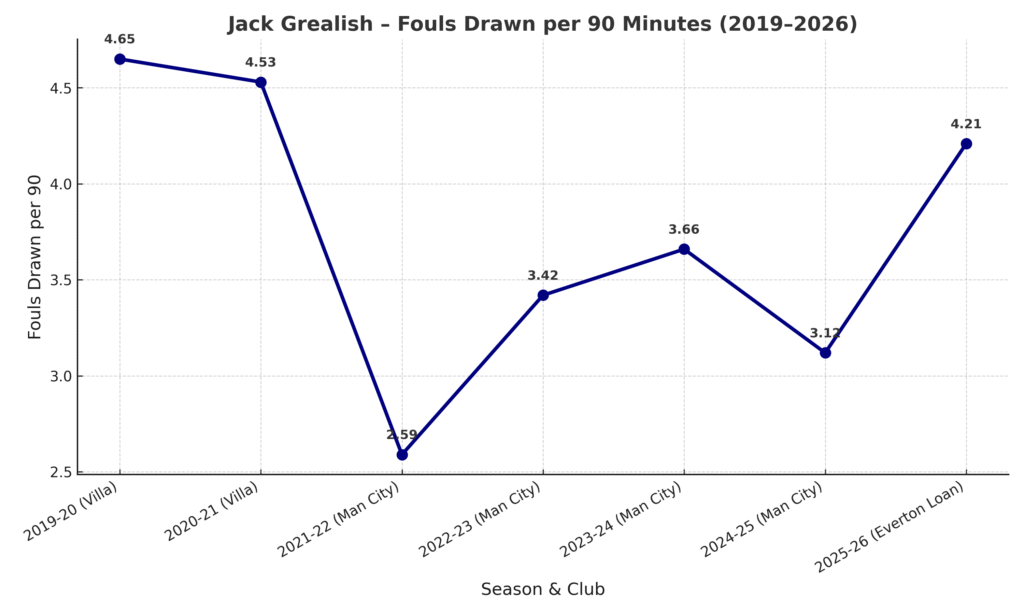
In his final two seasons at Aston Villa, Jack Grealish was consistently fouled in the Premier League, averaging 4.65 fouls drawn per 90 in 2019–20 and 4.53 per 90 in 2020–21.
These numbers show the freedom he enjoyed at Villa, where he carried the ball, invited challenges, and forced defenders into mistakes.
The contrast became clear after his £100 million move to Manchester City. In his debut season (2021–22), Grealish’s fouls drawn dropped dramatically to 2.59 per 90, almost half his Villa output.
While the numbers improved slightly in subsequent campaigns at City — 3.42 in 2022–23, 3.66 in 2023–24, and 3.12 in 2024–25 — they never returned to his Villa peak.
This can indicate how Guardiola’s system limited his time on the ball and opportunities to engage defenders.
Now at Everton, the trend has swung back in his favour. So far in the 2025–26 season, Grealish is drawing 4.21 fouls per 90, almost identical to his Villa prime.
Take-Ons Attempted per 90
The number of take-ons per 90 minutes shows how much freedom a player has on the ball.
A high count means he is encouraged to take on defenders, commit opponents, and force openings in the final third. It’s similar to fouls drawn, but instead of waiting for contact, the player actively drives at defenders to make things happen.
Dribbles not only push their team forward but also generate chances by disrupting defensive lines and carving out space for assists.
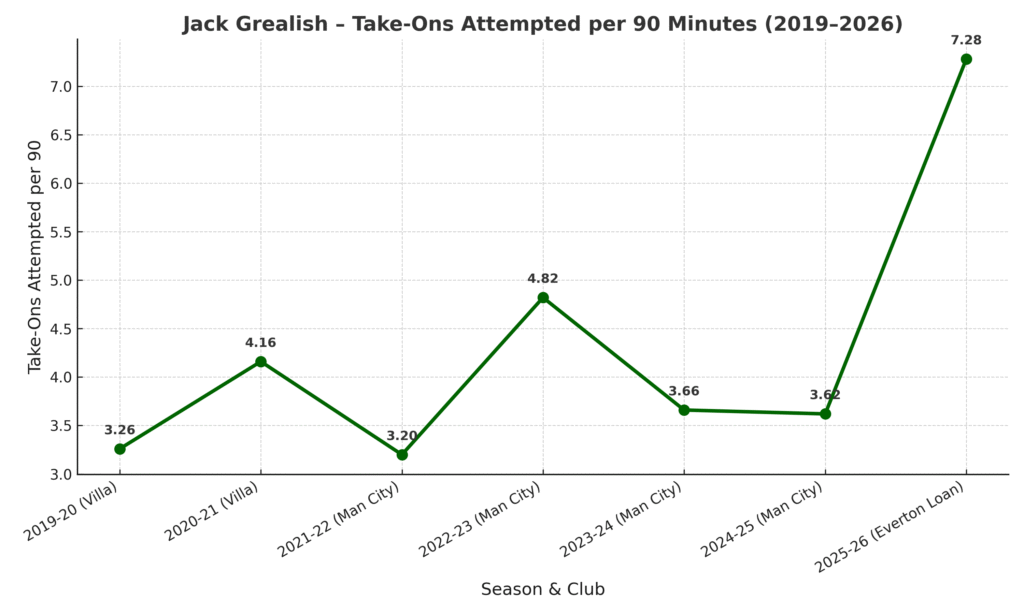
In his final season at Aston Villa (2020–21), Jack Grealish averaged 4.16 attempted take-ons per 90 minutes.
After moving to Manchester City, that figure noticeably dropped, averaging just 3.83 attempted take-ons per 90 across four seasons (2021–22 to 2024–25).
The contrast could not be clearer when compared to his loan spell at Everton (2025–26), where Grealish’s attempted take-ons have exploded to 7.28 per 90, almost doubling his City output.
The Sun wrote:
“It’s safe to say Jack Grealish is loving life at Everton. He’s finally broken free from Pep Guardiola’s grasp and is balling out again — four assists in two games and already adored by Everton fans. It’s great to see him getting back to the player we all know he can be.”
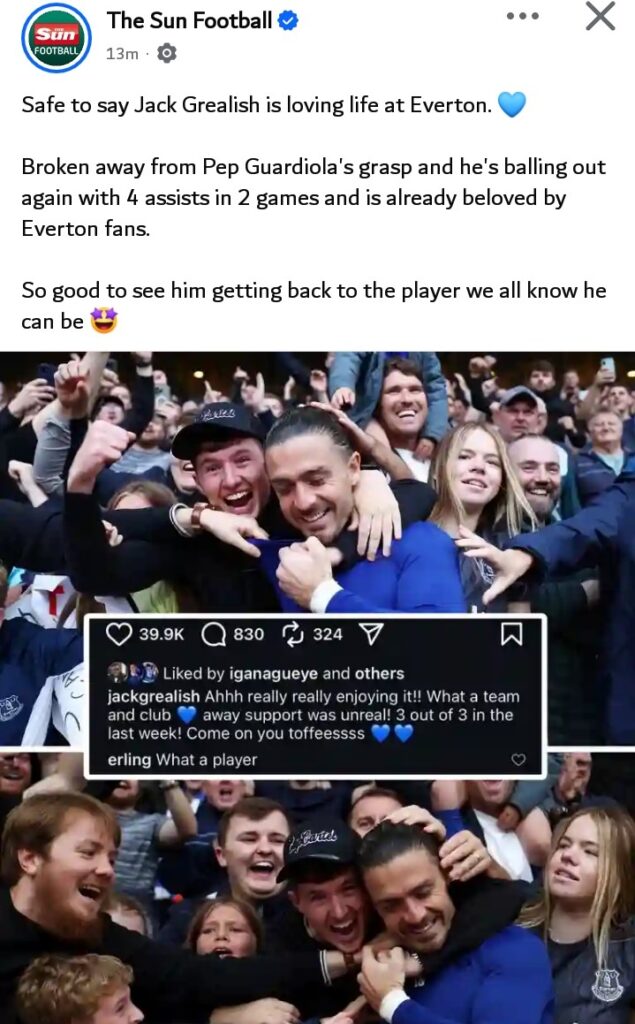
Goals and assists
How did this freedom translate into Jack Grealish’s goal contributions at Aston Villa, Manchester City, and Everton?
The statistics reveal a clear trend — Grealish delivers far more goals and assists when he plays in a system that gives him the creative freedom to dictate play
After moving to Everton, Jack Grealish has gone on to win his first-ever Premier League Player of the Month award after a stellar start to the season.
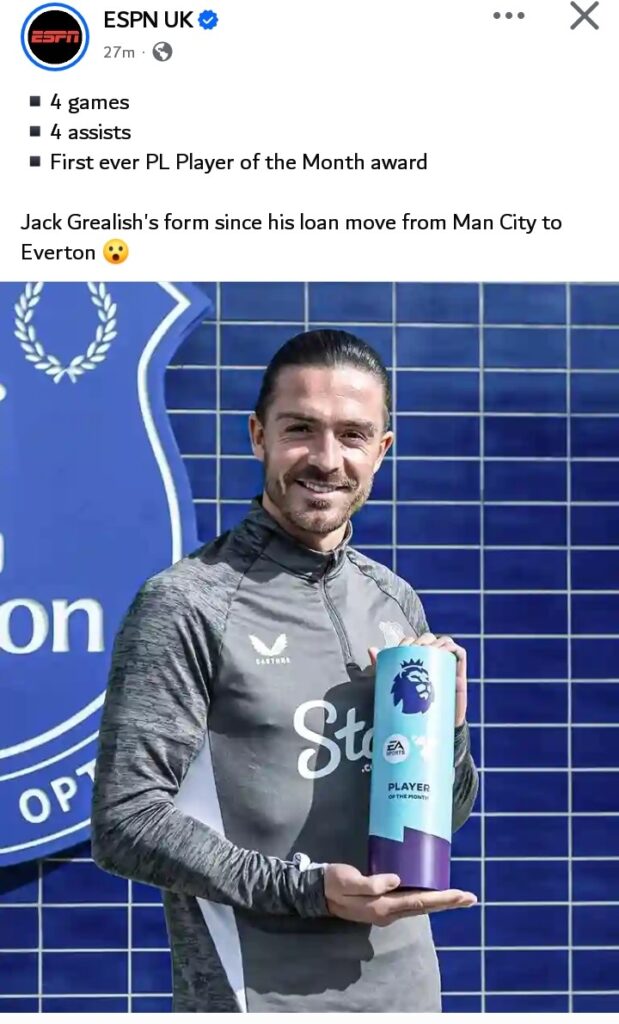
Another fan on social media remarked this after Jack Grealish won his first PL player of the month award. He commented, “Finally free from that robot coach and suddenly turned to a monster player. You cant write this script. Another one said, “He (Jack Grealish) left Manchester City to become player of the month in Everton. It is looking like Pep is really the problem here.”
Another fan on social media reacted after Jack Grealish won his first Premier League Player of the Month award, saying:
“Finally free from that robot coach and suddenly turned into a monster player. You can’t write this script.”

Another fan added:
“He left Manchester City and became Player of the Month at Everton. It’s starting to look like Pep might really have been the problem here.”

It therefore came as a shock to many when Jack Grealish was left out of the England squad for the Three Lions’ international fixtures around 9th October 2025.

Jack Grealish Was Outstanding at Aston Villa
In his final two seasons at Aston Villa, Jack Grealish established himself as one of the Premier League’s most dangerous attacking midfielders.
In the 2019–20 season, he produced 8 goals and 6 assists in 36 appearances.
The following campaign, 2020–21, he reached another level with 6 goals and 10 assists in just 26 games.
What stood out most was the freedom Grealish enjoyed at Aston Villa. He dictated the majority of Villa’s attacking play, threading precise passes with composure, carrying the ball into dangerous areas, and consistently driving at the opponent’s penalty box.
His blend of calm playmaking and fearless forward runs made him Villa’s talisman.
It was this combination of creativity, end product, and attacking authority that convinced Manchester City to break the bank and sign Grealish for a record fee.
Jack Grealish Struggled at Manchester City
After leaving Aston Villa for a record transfer fee, Jack Grealish’s numbers at Manchester City never lived up to expectations.
In his first Premier League season (2021–22), he managed just 3 goals and 3 assists in 26 appearances, with four of those games coming off the bench.
The 2022–23 season showed slight improvement as he registered 5 goals and 7 assists in 28 appearances (including five as a substitute).
However, the following campaign saw his influence decline sharply. In 2023–24, Grealish recorded only 3 goals and 1 assist in 20 appearances, half of which came as a substitute.
By the 2024–25 season, his role had diminished even further. Despite making 20 league appearances, 13 were from the bench, and he contributed just 1 goal and 1 assist all season.
For a £100 million signing expected to transform City’s attack, these figures indeed show Grealish struggled to find consistency and freedom under Pep Guardiola – he was not the same player who had left Aston Villa.
Jack Grealish at Everton: A Different Player
The 2025–26 Premier League season has seen a rejuvenated Jack Grealish on loan at Everton, and has now started drawing strong comparisons to his best years at Aston Villa.
In just 7 league appearances (including one from the bench), he has already produced 4 assists and 1 goal, a return that highlights his growing influence in the final third.
At Everton, Grealish looks far more liberated than he ever did at Manchester City. He is being allowed to roam between the lines, drift into dangerous pockets of space, and link up with teammates in fluid, unpredictable ways.
That freedom has reignited his creativity, making him once again the type of player who dictates attacking play rather than simply fitting into a rigid system.
Though it’s still early in the season, Jack Grealish already ranks among the players who have created the most chances so far — alongside the likes of Florian Wirtz, Bryan Mbeumo, and Bruno Fernandes, who, it could be argued, are playing in far more expensive and well-established team setups than Grealish.
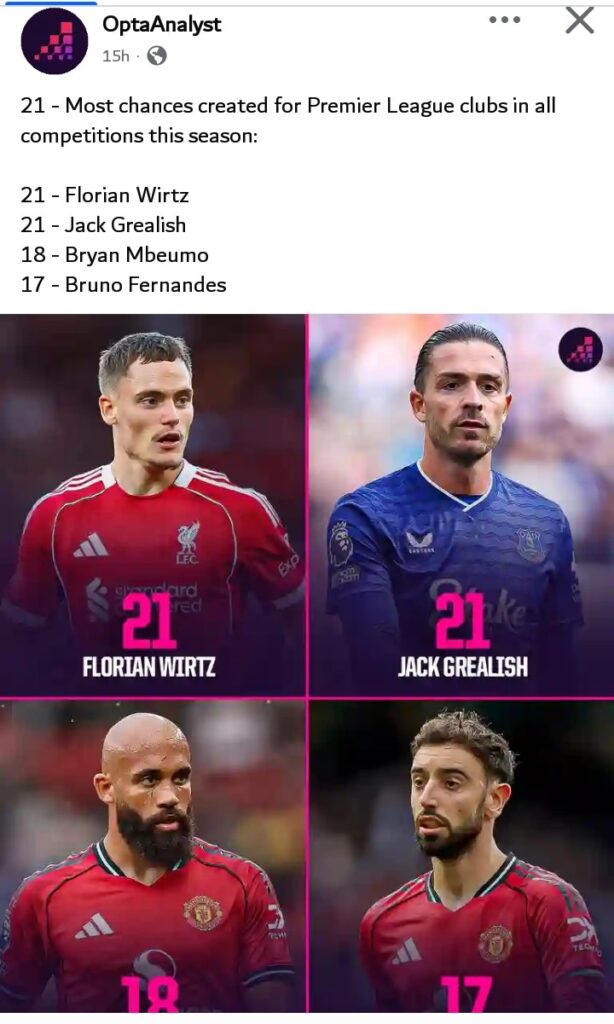
Another football fan suggested that Everton may have intentionally doubled down on recruiting players with the same qualities and playing style as Jack Grealish — implying there’s a deliberate strategy to strengthen the team with technically gifted dribblers who thrive in tight spaces.
One fan commented:
“Everton have brought in Jack Grealish and Tyler Dibling this season (ahead of the 2025–26 campaign)… and honestly, Dibling looks like a Grealish regen.”
Another added:
“I’m convinced that Tyler Dibling is a Grealish regeneration.”
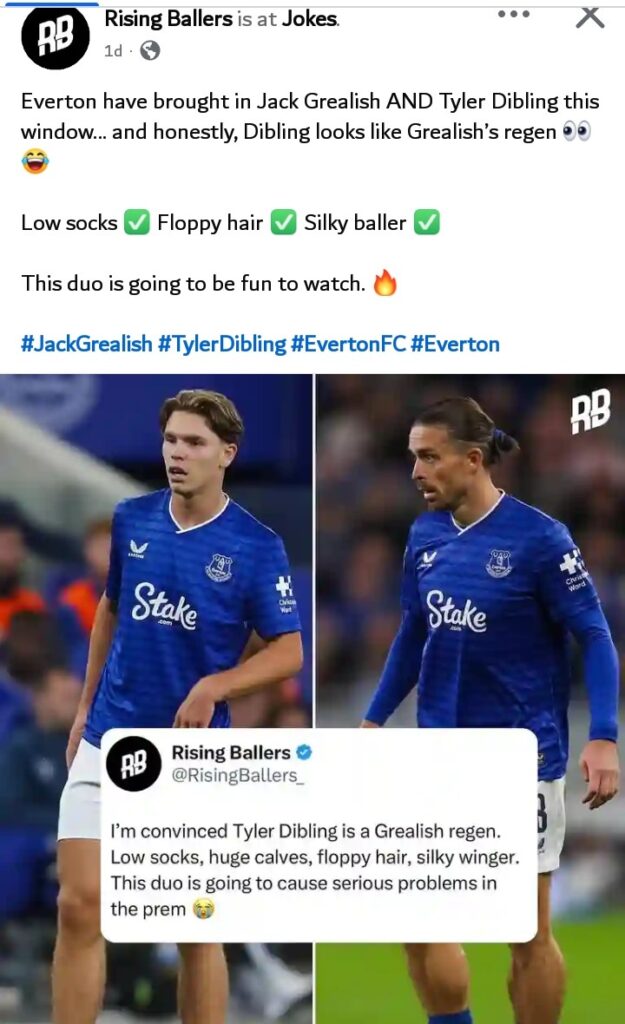
How Jack Grealish’s Other Statistics Have Evolved Over Recent Seasons
Shots on Target (%)
Shots on target measure how many of a player’s attempts actually test the goalkeeper, giving a clear indicator of how clinical and efficient they are in front of goal.
For Jack Grealish, this stat reveals the highs and lows of his Manchester City spell and his rebirth at Everton.
| Season | Club | Shots on Target (%) |
|---|---|---|
| 2025–26 | Everton (Loan) | 50.0% |
| 2024–25 | Manchester City | 33.3% |
| 2023–24 | Manchester City | 22.7% |
| 2022–23 | Manchester City | 36.6% |
| 2021–22 | Manchester City | 35.6% |
| 2020–21 | Aston Villa | 34.0% |
| 2019–20 | Aston Villa | 31.9% |
In his first two seasons at City (2021–22 and 2022–23), Grealish was steady, hitting 35.6% and 36.6% of his shots on target — respectable numbers for a creative midfielder adapting to Pep Guardiola’s system.
But his sharpness dipped dramatically in 2023–24, where only 22.7% of his shots were on target, his lowest return in the Premier League.
Fast forward to the 2025–26 season, and the loan move to Everton has transformed him.
Grealish is back firing, boasting an impressive 50% shots-on-target rate — clear evidence that the freedom and confidence allowed by the experienced David Moyes are helping him rediscover the clinical edge he once displayed at Aston Villa.
Assists per 90
Assists per 90 is one of the clearest indicators of how effective an attacking midfielder is at creating goals for teammates. In this case, its shows just how much Grealish’s output could have been restricted at Manchester City compared to Aston Villa and now Everton.
| Season | Club | Assists per 90 |
|---|---|---|
| 2025–26 | Everton (Loan) | 0.65 |
| 2024–25 | Manchester City | 0.12 |
| 2023–24 | Manchester City | 0.09 |
| 2022–23 | Manchester City | 0.31 |
| 2021–22 | Manchester City | 0.14 |
| 2020–21 | Aston Villa | 0.41 |
| 2019–20 | Aston Villa | 0.17 |
During his City spell, Grealish posted some of the lowest assist numbers of his career — just 0.09 assists per 90 in 2023–24, 0.12 in 2024–25, and 0.14 back in 2021–22.
Those figures are a far cry from the 0.41 assists per 90 he produced in his final season at Aston Villa.
Fast forward to 2025–26, and Grealish’s loan move to Everton has reignited his playmaking spark.
He is averaging an outstanding 0.65 assists per 90, his best return since leaving Villa, proving that when given freedom and responsibility, his creativity can flourish at the very highest level.
The signing of Jack Grealish has received the stamp of approval from former Everton manager Sean Dyche, who admitted that he had wanted to bring Grealish to Goodison Park months before the deal happened.
Dyche revealed that both Jack Grealish and Kiernan Dewsbury-Hall were among his top transfer targets for Everton around twelve months ago.
He said:
“I respect David Moyes and what he’s done, but he’ll know that we were trying to sign a lot of those players. We went in for Dewsbury-Hall and Jack Grealish.”

Progressive Passing Distance (Yards) per 90
Progressive passing distance measures how effectively a player advances the ball with their passing — to break defensive lines or push the attack closer to goal and relieve pressure on the defense. It is a clear gauge of a player’s forward drive and intent.
| Season | Club | Progressive Passing Distance (yards) per 90 |
|---|---|---|
| 2025–26 | Everton (Loan) | 120.59 |
| 2024–25 | Manchester City | 123.08 |
| 2023–24 | Manchester City | 95.35 |
| 2022–23 | Manchester City | 113.17 |
| 2021–22 | Manchester City | 101.05 |
| 2020–21 | Aston Villa | 181.05 |
| 2019–20 | Aston Villa | 161.15 |
At Aston Villa, Grealish was elite in this area, averaging 181.05 yards per 90 in 2020–21 and 161.15 in 2019–20.
His output dropped after joining Manchester City – he managed 101.05 yards per 90 in 2021–22, improved slightly to 113.17 in 2022–23, but dipped again to 95.35 in 2023–24. The following season saw a modest rise to 123.08 yards per 90.
On loan at Everton in 2025–26, Grealish is averaging 120.59 progressive passing yards per 90 — a number that would have ranked as his second-best during his Manchester City career, and a strong indication that he may be edging back toward his peak levels..
Tackles per 90
Tackles per 90 measure how often a player successfully wins the ball back, an important contribution for the modern-day midfielder, who is now also expected to put in a defensive shift.
| Season | Club | Tackles per 90 |
|---|---|---|
| 2025–26 | Everton (Loan) | 1.78 |
| 2024–25 | Manchester City | 1.12 |
| 2023–24 | Manchester City | 1.16 |
| 2022–23 | Manchester City | 1.09 |
| 2021–22 | Manchester City | 0.85 |
| 2020–21 | Aston Villa | 1.28 |
| 2019–20 | Aston Villa | 0.81 |
While not primarily known for defensive steel, Jack Grealish’s tackling numbers give insight into his work rate off the ball.
At Aston Villa, his returns were modest — 1.28 tackles per 90 in 2020–21 and 0.81 in 2019–20.
Under Pep Guardiola at Manchester City, his defensive contribution initially shrank, bottoming out at 0.85 in 2021–22, though he improved slightly with 1.09 in 2022–23 and 1.16 in 2023–24. By 2024–25, he averaged 1.12 tackles per 90.
At Everton, however, Grealish looks far more engaged defensively. His current 1.78 tackles per 90 in 2025–26 is his career best, which can indicate a rejuvenated player who is working hard on and off the ball.
Interceptions per 90
Interceptions per 90 capture how well a player anticipates danger and disrupts opposition passes — a reflection of tactical awareness and defensive positioning.
| Season | Club | Interceptions per 90 |
|---|---|---|
| 2025–26 | Everton (Loan) | 0.65 |
| 2024–25 | Manchester City | 0.25 |
| 2023–24 | Manchester City | 0.54 |
| 2022–23 | Manchester City | 0.31 |
| 2021–22 | Manchester City | 0.38 |
| 2020–21 | Aston Villa | 0.49 |
| 2019–20 | Aston Villa | 0.61 |
At Villa, he recorded 0.61 interceptions per 90 in 2019–20 and 0.49 in 2020–21, respectable numbers for a forward-minded player.
At City, though, he became less involved in winning the ball back, dropping to 0.38 in 2021–22 and 0.31 in 2022–23, with only 0.25 in 2024–25. A slight spike came in 2023–24 (0.54), but the overall picture showed diminished defensive input.
This season at Everton, Grealish has improved again, posting 0.65 interceptions per 90, his highest since leaving Villa.
Aerials Won per 90
Aerial duels may not be Jack Grealish’s strongest suit, but they highlight physical competitiveness and ability to retain possession under pressure.
| Season | Club | Aerials Won per 90 |
|---|---|---|
| 2025–26 | Everton (Loan) | 0.32 |
| 2024–25 | Manchester City | 0.12 |
| 2023–24 | Manchester City | 0.27 |
| 2022–23 | Manchester City | 0.61 |
| 2021–22 | Manchester City | 0.66 |
| 2020–21 | Aston Villa | 1.03 |
| 2019–20 | Aston Villa | 0.56 |
At Aston Villa, he was surprisingly solid in this metric, winning 1.03 aerials per 90 in 2020–21 and 0.56 in 2019–20.
At Manchester City, his involvement fluctuated: 0.66 in 2021–22, 0.61 in 2022–23, then falling to 0.27 in 2023–24 and 0.12 in 2024–25, reflecting less reliance on him in aerial contests.
Now at Everton, Grealish is contributing 0.32 aerials won per 90 — not outstanding, but an improvement on his later City numbers, showing he is at least competing more often for high balls.
Why Did Pep Guardiola Sell Cole Palmer?
When Cole Palmer left Manchester City shortly after scoring a sublime goal against Arsenal in the 2023 Community Shield, few truly noticed the significance of his departure.
That finish against Arsenal was the first of the initial highlights of Palmer’s composure and technical brilliance in front of goal (watch here), yet only weeks later he was on his way out of the Etihad.
At Chelsea, everything changed. Palmer quickly evolved into one of the Premier League’s most influential creative midfielders.
His vision, crisp passing, and composed finishing have made him a key figure for the Blues—proof of the immense talent City allowed to slip through their fingers.
So why did Pep Guardiola, arguably the greatest manager of the modern era, allow such a gifted playmaker to leave?
The simple answer is that Palmer wanted regular game time. The more complex question, however, is why Guardiola—renowned for nurturing world-class talent—was unable to carve out a meaningful role for him in a Manchester City squad that has undergone constant changes, often giving minutes to players with far less experience in the English game (due respect to other leagues in Europe).
If Palmer is as good as his Chelsea form suggests—and all the evidence points that way—the reality becomes clear: Palmer was not fully compatible with Guardiola’s intricate, positional system.
And there is truth in that. Since leaving City, Palmer has thrived, proving he can dictate games at the highest level.
He may not yet be at the creative heights of legends like David Silva, Juan Mata, Santi Cazorla, Mesut Özil, or Philippe Coutinho in their prime, but he has already shown that he belongs among Europe’s most exciting attacking midfielders.
Déjà Vu: Jack Grealish’s Story
If Palmer’s case feels familiar, it’s because we’ve now seen a similar narrative —with Jack Grealish.
Even before joining City, Grealish was a household name and Aston Villa’s talisman. While not the most tireless presser off the ball—certainly not with the intensity of Martin Ødegaard at Arsenal—he was a creative force with the ball at his feet.
His dribbling, ability to carry possession, and knack for opening up defenses convinced Guardiola to sanction a British-record £100 million transfer.
But at City, Grealish never quite looked the same. The freedom he thrived on at Villa was stripped away, replaced by rigid positional responsibilities. Now, on loan at Everton under David Moyes, Grealish looks reborn.
At 30, he has rediscovered his swagger—gliding past defenders, threading incisive passes, and driving his team forward with sheer creative will.
This is the Grealish City thought they were buying, only now he is flourishing away from Guardiola’s controlled “framework”.
David Moyes, with decades of Premier League experience, seems to understand Grealish for what he truly is: not just another cog in a tactical machine, but a genuine match-winner capable of changing games on his own.
Conclusion: Football Has Changed — But There’s Still Space for Individual Brilliance
The bigger picture here is how modern football itself has evolved. Today’s game is more structured than ever, with managers demanding positional discipline, precise passing rotations, and collective movement over individual freedom.
Under Guardiola, Mikel Arteta, and even to an extent Jürgen Klopp, the philosophy is clear: progress the ball quickly through short passing, recycle possession with efficiency, and only dribble forward when space allows.
The days of a single playmaker dismantling deep defenses on his own—like Jack Wilshere once tried at Arsenal—are becoming rare. But they haven’t disappeared either, as Jack Grealish’s rejuvenation at Everton this season has shown.
While Pep’s tactical approach is ruthlessly effective, it also limits naturally expressive players like Palmer and Grealish, who thrive on instinct, risk-taking, and flair.
Yet, Palmer’s resurgence at Chelsea and Grealish’s revival at Everton prove that football still has room for mavericks—players who break structure and decide matches with their individual brilliance. Provided they are given freedom and trust, talents like these remind us that creativity can still shine through even in an era dominated by tactical systems.

Leave a Reply